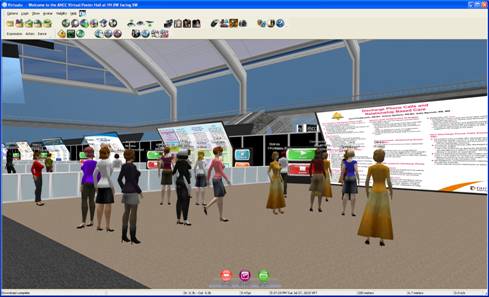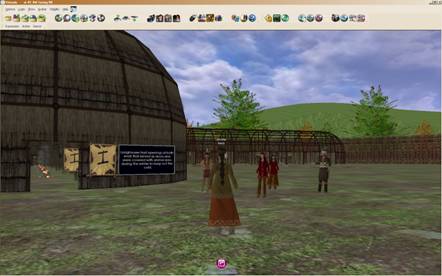Companies looking to hold virtual conferences first have to decide whether to hold a Web-based conference – normally some combination of streaming video, live chats, slide shows, and social media – or one in an immersive environment. The immersive conference allows avatars to walk around inside a three-dimensional virtual environment, but can be more difficult to use than a Web-based platform.
But it doesn’t have to be an either-or decision.
One vendor, Jamestown, NY-based Digitell Inc., offers a virtual conferencing platform that allows visitors to attend the same conference either by avatar or in 2D via a browser.

We’re the only company with a 2D and 3D integrated system, Digitell CEO James Parker told Hypergrid Business. “If you’ve got 55-year-old executives who just wants to watch the conference in a 2D player, they can. And others can come into the immersive environment – and all the features and options are connected.â€
The Web-based, 2D viewer is quicker to load and easier to learn how to use but the majority of attendees – 87 percent – opt for the immersive, avatar experience instead, said Parker.
Those viewing the conference via a 2D browser window can watch the streaming speaker videos, see the slide shows, and even text chat with other attendees – both other Web attendees and those present via their avatars. The Web visitors can’t hear voice conversations of the other attendees, however, but this isn’t normally turned on for large conferences, Parker added. In conference situations, the speeches are usually streamed in via live video, and attendees ask questions by text chat to avoid disrupting the presentations.
Voice chat is normally used for internal association meetings – event organizers, for example, getting ready for the conference – and they would all be attending via avatar.
Focusing on industry groups
Digitell clients are mostly industry associations, including several professional nursing groups.
We’re helping associations extend the life of their meetings by building virtual meeting halls,†said Parker.
In fact, the company’s main line of business is learning management for professional associations and organizations.
“We run the world’s largest library of professional content, with over 42,000 multimedia lectures,†said Parker.
The company has about 90 customers for its non-immersive offerings, including the Academy of Medical-Surgical Nurses, the American Association of Museums, the American Public Works Association, the American Society of International Law, and many others.
And about 15 are using the company’s VirtualU 3D immersive meeting platform, Parker said.

Built on Activeworlds
Digitell’s VirtualU immersive environment in built on top of the Activeworlds virtual world platform. The way the world works is more similar to Teleplace and ProtoSphere and Blue Mars than Second Life.
Second Life and OpenSim are region-based – 16-acre squares laid out in a checkerboard pattern.
VirtualU is room based, with each room its own little separate world. To move from room to room, users have to teleport, and they can’t look from one room to another. A room can be shaped like a room or a conference auditorium, or it can be an exterior space with a sky and grass. When users walk beyond the buildable area, they see in front of them an endless plain.
Another point of different is that Second Life and OpenSim use primitives – basic building blocks like cubes and spheres that can be deformed into any shape. Last year, both platforms rolled out support for mesh objects created in professional design programs, but almost all content is still built from primitives.
VirtualU – like Teleplace, ProtoSphere and Blue Mars – is a fully mesh-based world. Content is created in professional design programs and imported. However, there are some in-world editing abilities – mesh objects can be scaled, moved and rotated, and new images – textures — applied to their surfaces.
Finally, Second Life and OpenSim allow users to have avatar inventories – clothing, accessories, furniture, even entire buildings. These objects can be obtained free or at low cost from in-world vendors and Web-based marketplaces.
VirtualU avatars have no inventories – the only clothing or accessories user avatars have is what is built into the environment. Clients can add custom clothing to the environment, however.
There is no concept of inventory,†James Newman, Digitell’s director of virtual technology, told Hypergrid Business. “There is no user-created clothing that you can give to someone or purchase.â€
And the avatars themselves aren’t as customizable as in Second Life.
For corporate clients, however, users’ inability to go into a virtual S&M shop and pick up adult attachments might be a benefit, not a disadvantage.

“We’re not trying to create the next Second Life, or a large social community around the platform,†said Newman. “What we’re all around is building specific branded environments for our clients to fit whatever needs that might be.â€
For example, Digitell can create custom logo T-shirts for a client that users can wear by loading them from the viewer menu.
For one project, a custom-built virtual Iroquois Indian Tribe learning environment, Digitell created custom Native American headdresses for the different tribes — in addition to buildings and other features of the virtual environment.
- OSgrid back online after extended maintenance - April 16, 2025
- Analysts predict drop in headset sales this year - March 25, 2025
- OSgrid enters immediate long-term maintenance - March 5, 2025
